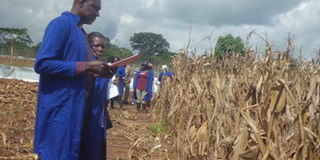Maize trials show promising results

Scientists collect data during the field trials. There are ongoing efforts to have maize that is both drought tolerant and pest resistant. PHOTO BY LOMINDA AFEDRARU
What you need to know:
Ugandan scientists breed maize varieties that deal with the farmer’s two main challenges.
Farmers growing maize in Uganda and East Africa are faced with a pest and disease burden leading to low yields. So, scientists look to breed resistant varieties.
In Uganda, the scientists are making headway in tackling stem borers using the biotechnology mechanism. For the last three years, they been conducting research on maize varieties that are less prone to drought, which seemed promising. But they are faced with the challenge of stem borer.
This led them to begin breeding maize varieties, which are resistant to stem borers by introducing Bacillus thurigiensis (Bt) gene into a number of varieties to test resistance against two types of stem borers, namely Chilo partellus and Busseola fusc.
Results from trials
The three-year research is under the Water Efficient Maize for Africa (WEMA) project. Under this, National Agricultural Resources Research Institute (NaCRRI) in Namulonge has been conducting research by developing varieties, which are tolerant to drought. It was realised that maize growers are faced with the challenge of stem borers.
The first field trial was concluded in April with the NaCRRI team harvesting the product for data evaluation.
Dr Micheal Otim, the team leader, says this was is to evaluate the efficacy of Bt maize variety in controlling stem borers.
“We introduced three weevils per plant after three months from planting season, followed by weekly introduction three times, meaning each plant was infested with 30 insects per plant. We then kept monitoring the damage caused on the leaves until harvesting time,” Dr Otim narrated.
The team planted about 20 different varieties with eight transgenic and eight isolates, with no genetically modified genes.
The transgenic material was obtained from International Maize, Food and Improvement Centre (CIMMYT). Three varieties were local varieties: Longe6H, Longe10H and DK8031. The rest of the varieties are coded as entrants from 1-16
At the trial site, part of the field was infested with stem borers and the other part of it was not. The results showed that the transgenic varieties gave good yields despite infestation but the non-transgenic varieties were destroyed, with a few lines showing poor yields.
This trial is a regulatory requirement during the research stage. The team intends to repeat this trial two more times to evaluate if the performance is consistent. Thereafter, the resistant varieties will be incorporated in the local farmer-preferred varieties for final release to the farmers.
Dr Otim explains that this particular transgenic variety contains certain protein called cry1AB, derived from a bacterium that lives in the soil. When consumed by stem borers either from the leaves or cobs, there are receptors that end up killing the insects.
This trial is going on in other countries where the WEMA project is taking place including Kenya, Mozambique, Tanzania and South Africa, who are already consuming the product.
Dr Godfrey Asea, head of cereal research, NaCCRI, explains the statistics of maize production in Uganda. It doubled by 2.5 million metric tonnes compared to three years ago. This is mainly because a number of farmers are now using fertilisers as manure and herbicides to control weed.
Dual resistance
“If farmers are able to increase their production by observing proper agronomy practices, then this means production will rise when they use varieties bred using advanced technologies like biotechnology,” Dr Asea says.
The team will combine genes of drought tolerant maize with Bt maize so that farmers will purchase only one variety but with dual resistance.
CIMMYT statistics indicate that insect pests affect 46 per cent of the global maize-growing area. They destroyed a quarter of the maize grown globally every year.
This destruction is valued at 25 million metric tonnes worth $5.7b (Shs14.6t). Also, farmers trying to control the pest use $550m (Shs1.2t) to purchase insecticides annually. More than 60 per cent of losses occur in the tropics where environmental conditions are favourable to the insects.
This, therefore, means breeding maize varieties resistant to both drought and stem borers will greatly benefit smallerholder farmers in Sub-Saharan Africa, including Uganda.
stem borers in uganda
Stem borer is highly-prevalent in Uganda and much of sub-Saharan Africa, where it damages maize. It affects leaves, stems, roots and the maize cob and they are of different types. Two of them are known to be destroying maize crop varieties in farmer’s fields mainly in Uganda.




